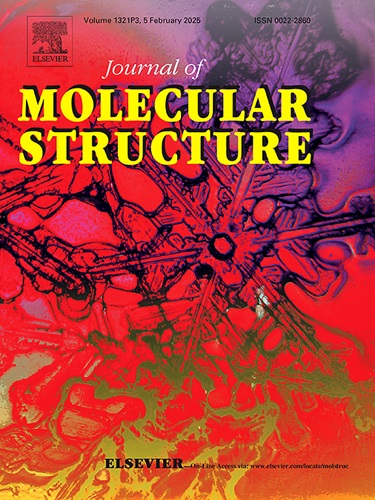Nano-encapsulation of epigallocatechin gallate (EGCG) within zeolitic imidazolate framework-8 (ZIF-8) and controlled release of EGCG
IF 4
2区 化学
Q2 CHEMISTRY, PHYSICAL
引用次数: 0
Abstract
Epigallocatechin Gallate loaded Zeolitic Imidazolate Framework-8 (E-ZIF-8) nanoparticles were synthesized utilizing a synchronized nano-encapsulation method. The structural and characteristics of these nanoparticles were analyzed using SEM, UV–Vis, EDX, TEM, DLS, FTIR, TGA, and XRD. E-ZIF-8 was synthesized through the coordination of zinc nitrate and 2-methylimidazole in the presence of the bioactive EGCG molecules. The structure analysis results show that E-ZIF-8 presents a uniform and regular dodecahedral morphology with particle sizes below 200 nm. The zeta potential indicates that E-ZIF-8 nanoparticles exhibit a surface charge ranging from 30 to 50 mV, and TGA results show that the degradation temperature has increased, confirming a dramatic improvement in physicochemical stability. The EGCG loading capacity of E-ZIF-8 was quantified at 193±1 mg/g, showcasing substantial radical scavenging activity against both ABTS and DPPH radicals. Furthermore, E-ZIF-8 nanoparticles displayed pH-dependent drug release profiles. EGCG reached equilibrium of release within 1 hour, with cumulative release rates exceeding 90 % at both pH 6.8 and pH 2.0. In contrast, the release rates under the protective ZIF-8 delivery system were significantly reduced, with release percentages of 32.86±1.12 % and 57.82±1.66 % at the same time point. After 5 h, the cumulative release rates were only 62.56±2.10 % and 77.75±1.06 %, respectively. The synchronized nanoscale encapsulation technique effectively facilitates the encapsulation and sustained release of EGCG, demonstrating superior therapeutic efficacy compared to free EGCG. These findings suggest that the concurrent nano-encapsulation strategy of E-ZIF-8 enhances the stability and bioavailability of EGCG, positioning E-ZIF-8 as a promising pH-responsive nanoplatform for drug delivery applications.

未食子儿茶素没食子酸酯(EGCG)在沸石咪唑酯框架-8 (ZIF-8)内的纳米包封及EGCG的控释
采用同步纳米包封法制备了表没食子儿茶素没食子酸酯负载咪唑酸沸石骨架-8 (E-ZIF-8)纳米颗粒。采用SEM、UV-Vis、EDX、TEM、DLS、FTIR、TGA、XRD等分析了纳米颗粒的结构和特性。在具有生物活性的EGCG分子存在下,通过硝酸锌和2-甲基咪唑配合合成了E-ZIF-8。结构分析结果表明,E-ZIF-8呈均匀规则的十二面体形貌,粒径在200 nm以下。zeta电位表明,E-ZIF-8纳米粒子的表面电荷在30 ~ 50 mV之间,TGA结果表明,降解温度升高,证实了其物理化学稳定性的显著提高。E-ZIF-8的EGCG负载能力为193±1 mg/g,对ABTS和DPPH自由基均有明显的清除活性。此外,E-ZIF-8纳米颗粒表现出ph依赖性的药物释放谱。EGCG在1小时内达到释放平衡,在pH 6.8和pH 2.0下,累积释放率均超过90%。与此相反,在ZIF-8保护性给药体系下,释放率明显降低,同一时间点的释放率分别为32.86±1.12%和57.82±1.66%。5 h后的累积释放率分别为62.56±2.10%和77.75±1.06%。同步纳米级包封技术有效地促进了EGCG的包封和缓释,与游离EGCG相比,显示出优越的治疗效果。这些发现表明,E-ZIF-8的同步纳米封装策略提高了EGCG的稳定性和生物利用度,将E-ZIF-8定位为一种有前景的ph响应药物递送纳米平台。
本文章由计算机程序翻译,如有差异,请以英文原文为准。
求助全文
约1分钟内获得全文
求助全文
来源期刊

Journal of Molecular Structure
化学-物理化学
CiteScore
7.10
自引率
15.80%
发文量
2384
审稿时长
45 days
期刊介绍:
The Journal of Molecular Structure is dedicated to the publication of full-length articles and review papers, providing important new structural information on all types of chemical species including:
• Stable and unstable molecules in all types of environments (vapour, molecular beam, liquid, solution, liquid crystal, solid state, matrix-isolated, surface-absorbed etc.)
• Chemical intermediates
• Molecules in excited states
• Biological molecules
• Polymers.
The methods used may include any combination of spectroscopic and non-spectroscopic techniques, for example:
• Infrared spectroscopy (mid, far, near)
• Raman spectroscopy and non-linear Raman methods (CARS, etc.)
• Electronic absorption spectroscopy
• Optical rotatory dispersion and circular dichroism
• Fluorescence and phosphorescence techniques
• Electron spectroscopies (PES, XPS), EXAFS, etc.
• Microwave spectroscopy
• Electron diffraction
• NMR and ESR spectroscopies
• Mössbauer spectroscopy
• X-ray crystallography
• Charge Density Analyses
• Computational Studies (supplementing experimental methods)
We encourage publications combining theoretical and experimental approaches. The structural insights gained by the studies should be correlated with the properties, activity and/ or reactivity of the molecule under investigation and the relevance of this molecule and its implications should be discussed.
 求助内容:
求助内容: 应助结果提醒方式:
应助结果提醒方式:


